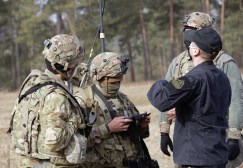Exiting DIU director urges Pentagon to refresh how it adopts commercial tech for future wars

In the months leading up to his exit as director of the Pentagon’s Defense Innovation Unit (DIU), Mike Brown and his team are helping get commercial technology into the hands of Ukrainians on the frontlines, who are skillfully deploying drones, artificial intelligence and other off-the-shelf solutions from American companies to combat Russian invaders.
This conflict is spotlighting in real-time how rapidly deployable commercial capabilities will be essential to winning wars going forward, according to Brown, and the U.S. needs to shake-up some of its technology adoption processes to effectively prepare.
“We’re seeing the change in front of our eyes in Ukraine — commercial technology is going to be more important and used in some new and different ways,” Brown told FedScoop in a recent interview. “I think it’s underscoring how important the mission of DIU is. As we think about warfare evolving over the next couple of decades, there’s going to be more and more of these commercial technologies that are going to be applied in warfare.”
Launched in 2015, DIU was designed as a mechanism to help the Defense Department team with the commercial sector and field cutting-edge capabilities to the military more quickly and less costly than traditional government buying methods allow. It now has outposts in several of the nation’s tech hubs including Silicon Valley, Boston, Austin, Chicago and Washington. Brown has led the unit for nearly four years and recently announced plans to depart in September when his term ends, despite an option to stay on.
He recently briefed FedScoop on a few of the challenges and activities that are shaping his final days steering DIU.
‘Game-changing’ tech for Ukraine
Since Russia invaded its neighbor in February, tech-savvy Ukranians have been leveraging several commercial technologies that DIU supported and worked on as part of its portfolio, including secure communications tools, drones and satellite imagery.
“As soon as we saw the events unfold and we saw the invasion was happening — with the U.S. getting involved to help NATO allies — we immediately highlighted the commercial technologies that we thought could be useful so that they would be able to be put on the security assistance lists that are provided to Ukraine and make sure that European Command, the force that’s working most closely with NATO, would have access to those,” Brown explained. Ukraine is not part of NATO but it is being supplied by members of the transatlantic alliance.
One of the less obvious of those DIU-supported capabilities that has enabled Ukraine to unleash “some pretty damaging effects” on the Russian military, in Brown’s view, is associated with synthetic aperture radar (SAR). This form of radar relies on different space-based sensors to provide satellite imagery of specific places of interest.
“We’re used to satellite images that are optical, where you’re looking at pictures with very high-tech cameras,” Brown explained. “But now it’s possible to get a radar image. That way, you can see through cloud, and you can see at night — and this has been a game-changer in Ukraine.”
Because the technology is commercially made, Brown said the U.S. could quickly share it with partners and Ukranians on the ground to help them gain a tactical advantage very early in the conflict.
“But also think about how the war unfolded, where the U.S. intelligence community was able to predict what was going to happen, frankly, flying in the face of what some thought, to say ‘No, [Russia’s Vladimir] Putin is amassing forces and he’s going to invade.’ And we were able to not only make that prediction, but share the pictures with the world,” Brown said.
That technology is still being used to provide intelligence about the movements and actions of Russian forces.
“And we’ve combined that with some artificial intelligence to actually do battlefield assessments,” Brown added.
When DIU initially started focusing on SAR technologies several years ago, officials’ original intent was to develop algorithms that would inform them of infrastructure destruction resulting from natural disasters.
“I live in California. So in California, wildfires are always on my mind. And we could give first responders a view of which roads were damaged or impassable, or what are the structures that now are gone,” Brown noted.
Now, the technology is helping to analyze how combat zones — such as Ukrainian cities and infrastructure — are affected by warfighting.
“They can do battlefield damage assessments, as soon as missiles are flying in the air. So, the Ukrainians can get a color-coded view using commercial technology of what is the damage that’s just occurred because these missiles have flown. That’s an example of kind of a game-changing technology, in terms of closer to real-time situational awareness, that we’re able to give Ukrainians and something that DIU has worked on,” Brown said.
DIU brought in a number of the vendors that are now contracted by the U.S. military to provide that imagery, Brown noted. Because it’s commercial technology, there were no classification issues to sort through and it could all be extended broadly without much lag time.
“We were able to scale up with a number of vendors that we’ve qualified so they could provide assistance in much higher quantities and much sooner than you might have with some of the more specialized gear,” he said.
Ideas for improvement
Commercial capabilities like SAR “are going to be needed on an ongoing basis and on an increasing basis” as warfare evolves to incorporate more and more digital assets, according to Brown.
While he prepares for his departure from DIU, the director and his team have been pressing Pentagon leaders to reimagine legacy acquisition methods, budgeting processes and fielding approaches for commercial technologies, which develop on much faster cycles.
Brown noted that his boss, Undersecretary of Defense for Research and Engineering Heidi Shyu recently published a list of 14 technologies that she views as critical for national security.
“Eleven of those 14 are being led by the commercial sector,” Brown noted. “So for these technologies, the military really needs a way to access what’s happening outside, which is why DIU was set up.”
Beyond gaining more awareness about emerging and applicable commercial solutions, the Pentagon also needs a revamped way to evaluate and adopt them much more frequently — because, according to Brown, new technologies in those key areas are being released every 12 to 18 months.
“We’ve advocated for something we call a ‘fast follower strategy’ where the military isn’t leading in the development of a technology … We need to be fast following what the commercial market is doing in areas like drones or commercial satellite imagery — and really have an alternative process that we’ve outlined, that would allow the military to more quickly assess and field those technologies,” he explained.
Brown suggested the DOD establish a new concept of “capabilities of record” that could parallel military budgeting for “programs of record.” The latter, part of a traditional acquisition setup that’s been used to procure fighter aircraft among other weapons and systems, focuses on specific requirements and often take decades to completely come to fruition.
“With commercial technology, we need a different process,” Brown said, adding that a new approach would work in a very fast cycle where solutions can be fielded to the military as quickly as companies make them available — in that 12-18 month timeframe.
There also needs to be a quicker way for government officials to sort out what DOD components might eventually be interested in buying the technologies.
“That’s one of the keys with commercial satellite imagery and other commercial technologies — we have to know where that’s going to be bought. These technologies were not developed for a specific service. It wasn’t like, ‘Okay, new ship, that’s going to the Navy,’” Brown said.
DIU’s budget is another concern.
The agency saw a $7 million reduction in funding from fiscal 2021 to fiscal 2022. The director said that dip was partially a function of how the organization is “so small,” and didn’t initially have the new administration’s sharp focus.
In the forthcoming fiscal years, though, Brown believes that trend will likely be “corrected.”
“I think we’ve given some visibility to the fact that the budget has gone down in a time when commercial technology is ever more important — and, frankly, the combatant commanders and warfighters are asking for more commercial technology because it can be deployed so much more quickly,” he noted.
During his final months at DIU, the CEO-turned-federal director is also pushing the Pentagon to create a “hedge” for America’s traditional, large weapons platforms, with commercial tech.
“Why? Because our adversaries — in some cases, China — have stolen some of the designs for our major weapons platforms. I’m particularly thinking about aircraft. And certainly all our adversaries have had a chance to study our warfighting concepts [… and] how we go to war with the equipment that we have, because the U.S. has been so involved globally in quite a few conflicts,” Brown said. “So, I feel like we need a hedge to be able to bring an element of surprise that’s brought by commercial capabilities.”
He added: “The combination of that hedging of the large platforms with commercial capabilities, experimenting and bringing new concepts to warfighters, and then being able to ingest that capability quickly using speed as an element of competition is going to be something that we need to improve upon — and those are the ideas that we put forward.”




